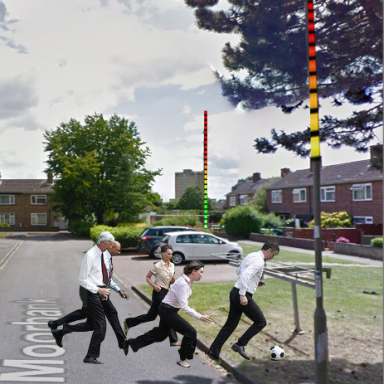LitKNIT Gateways is a “smart” version of urban knitting using LED stripes to create programmable landmarks and play a walkable light show across Oxford. Building on existing street furniture such as light posts, it weaves colorful light patterns into neighborhood gateways, knitting disparate demographics into an interactive illuminated metropolis.
People can interact with this network of illuminated gateways both physically (e.g. through touch, sound, or motions sensors embedded in street furniture) as well as via a web interface (e.g. smart phone). For example, on a micro level, pedestrians can touch a responsive light pole wrapped with LED stripes with both hands to see their heartbeat displayed as a pulsating color sequence. Or, they can swipe their hands, move across or jump next to the pole to set a light pattern in motion that spins around or moves up and down the pole. On a macro level, the gateways can be linked to a web interface and serve as a public display and sensor of basic city data. For example, a street light pole can become an equalizer bar showing the decibel level of local environmental noise from traffic (e.g. a car passing by) or air quality.
Taken as a whole, these interactive gateways aim at “weaving” together the larger city fabric (physically and digitally) in collaboration with local community organizations and residents. Collectively they can form a pathway to play a role in annual runs, nighttime walks, Critical Mass bicycle rides, and emergent urban games.


Can you explain how this works? My current understanding is that you’d have to clad lamp posts or other objects in specific neighbourhoods with LED surfaces and operating kit in order to allow for street level participants to activate individual segments while walking through these neighbourhoods. How would these disparate demographics understand what is going on?
I’m intrigued by the anonymity of the creators practice and the invisibility or subtlety of computer/virtual yarnbombing as opposed to the physical tactile version – isn’t the point of yarn bombing to be tactile and visible street art? I might have misinterpreted th concept – perhaps the materiality of light can be touched/felt?
Really like this novel concept that doesn’t disrupt people who need to get somewhere. Think it would be great for self-guided walks in Oxford
I think this would look beautiful.
I think this work has a really strong and intriguing idea behind it with expanding possibilities once installed. Would it also include a sound feedback element to it?
But I do wonder how “idiot proof” it needs to be…..
This sounds really enticing ; accessible in a casual way, as we all just go about our places and therefore I think engaging as many of us as possible. And fun. The digital interface will expand the potentials for various interpretation and visuals but it’s strength is that the experience is not reliant on the user being computer literate or internet inclined! The addition of sound would take it further, expand accessibility. Would they link to each other on some way? Public sreens showing the web interface dotted around …